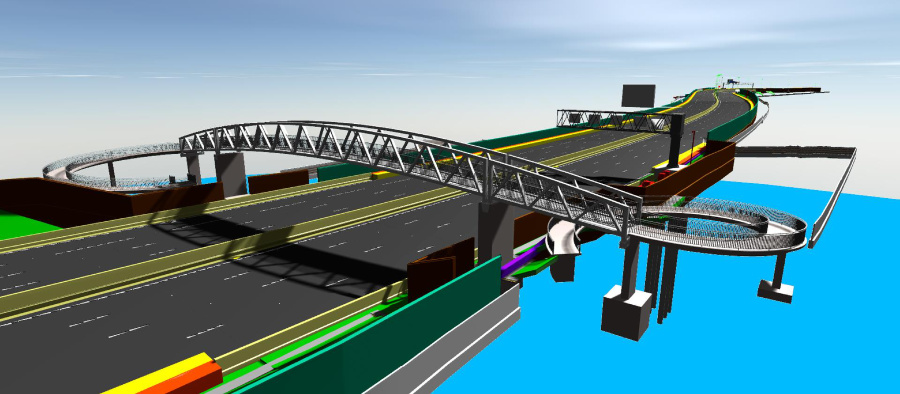Smart Motorways
How Design and Construction teams are working successfully in collaboration
Highways England is rolling out a programme of ‘smart motorways’ across the UK to improve capacity and journey time reliability on the strategic road network. Jacobs Atkins Joint Venture (JAJV) and Kier are working together on a number of sections of the Highways England network, including the upgrade of the M20, junction 3 to junction 5, to a smart motorway. JAJV has been contracted by Highways England to deliver the design (design partner), while Kier is responsible for construction (delivery partner).
From their experience of work on previous projects, the teams knew that communication was key to success. So, they worked closely together to ensure they could achieve the best possible outcome for Highways England and could provide the information each required to fulfil their roles.

Early in the project, a pivotal point was when the JAJV, Kier and Highways England teams came together and talked about taking a ‘soft landings’ approach to delivery – to ensure all decisions made during the project were based on improving the operational performance and meeting the client’s expectations, but also balancing this with being able to get the job done effectively. Initially, JAJV sent Kier a sample of each type of model for each discipline to see how they behaved in the BIMXtra environment – they talked together openly and honestly and made sure they got the job done.
Stacey Clifford, Kier’s BIM Manager, commented, “The models that JAJV was providing initially were ideal for the ongoing management of the motorway once it is built, but we needed a few more things to be able to use them successfully for construction – and it’s always easier if you can get these issues resolved up front as quickly as possible rather than finding out about them when you’re trying to carry out work on site,” said Stacey.
JAJV took the Employer’s Information Requirements (EIR) as a clear starting point for delivery and built on this in collaboration with Kier to ensure that they delivered the required information and format to work most effectively in construction. Jakub Dziurdz from JAJV said, “If Kier had different requirements to what was specified to enable them to efficiently and successfully construct the road, then we asked them honestly what they needed from us and delivered it wherever we were able.”
From his experience on previous projects, Stephen Barlow, Digital Design Lead at JAJV, knew the approaches that didn’t work and identified that it was generally down to conversations that weren’t happening or ones that should have started earlier. “We realised we had to ask straight away, ‘we’re planning to send you this…does that meet your requirements?’ It’s the first time I’ve worked in this way and the benefits are clear. Stacey could then come back and say, ‘no, we need to do 4D sequencing so need XYZ from you,’ and then we could work out whether it was possible for us to deliver that.”
The team worked collaboratively, ensuring that direct conversations were used to address requirements as efficiently as possible. This was backed up with the use of BIMXtra to raise Requests For Information, as part of the Communications tool, in a formal, logged manner, visible to the relevant parties for prompt action. BIMXtra is enabling the delivery partners to share information more easily and collaborate more efficiently across the project, and also visualise buildability and potential construction methodology using the Clearbox viewing engine, Insight, rather than trying to interpret multiple drawings and schedules.

The delivery partner, Kier, was given access to the JAJV Master Information Delivery Plan at an early stage of the project so that they fully understood Highways England’s requirements and what deliverables JAJV were expecting to issue. All parties involved in the process are validating all the information they receive against this and work together to ensure they’re delivering against it. Both teams had open and proactive dialogue regarding progress of deliverables so that everyone was informed and expectations were clearly set.
“Our relationship is transparent and honest. If we think there may be an issue we speak up and discuss it immediately to get it resolved,” adds Stephen.
Highways England carries out BIM Maturity Assessments on its supply chain, usually separately. But thanks to their close collaboration, Stephen suggested that Highways England assessed both JAJV and Kier together and the teams achieved a score of 100% for Stage Gate Assessment Review 5 - the end of Highways England’s Construction Preparation stage in its Major Project Framework Lifecycle.
“The Kier team has a valuable starting point – models that they really use effectively in the construction process. We’re updating work in our Common Data Environment and then passing it over to the Kier team. Although we’re contracted to develop models to enable Highways England to successfully manage the roads in operation, it’s also key for us to understand the information required by the Kier team about the assets for construction – the manufacturers details etc,” continued Stephen. “We manage data in a similar way to Kier so, moving forward, we’re looking to create a more seamless transition of information. We’ve got an information manager working on site so Kier can talk to them and understand what is and isn’t available – they know the models and the data available in them inside out. We’re now aiming to remove some of the redundant steps – for example, we were adding data to the models, only for Stacey to remove it and import it to BIMXtra separately…so it makes sense that we give it to her separately and then federate it together when we get it back to handover to Highways England.”
In fact, with both parties working in a data-centric rather than file-centric way the teams are really seeing the benefits. Stephen continues, “It has opened the door to have some really useful conversations around what can be done with structured data. We have done some pretty extensive data validation for the asset information that sits behind key discipline models. This has provided assurance to not only the client but to Kier on what data the models contain or are linked to. These exercises and conversations around data management for me have led to a better information flow from Designer to Delivery Partner, even in just the handover to construction.”
“Now that we have established we can move information quite successfully that way, it opens up the conversation about coming from construction back to designer with all the additional construction data that we can validate against client requirements for Kier.”
Jakub agrees that it is definitely the future, adding, “I can definitely see a benefit from two data-centric partners working together on the project. It helps us strengthen our position in the approach to the design process, where data should lead the way. It’s particularly important when we still see drawing-centric approach in many instances. The JAJV – Kier collaboration not only proves a point, but also allows us to look beyond what’s required.”
This collaboration has indeed resulted in a better understanding of what information is required right throughout the delivery and operation of new highways and will influence the processes undertaken and the deliverables defined in future smart motorways projects to ensure that the efficient working practices learnt on this project will be carried forward. It will also mean a seamless handover of as-built records into the maintenance phase for Highways England.